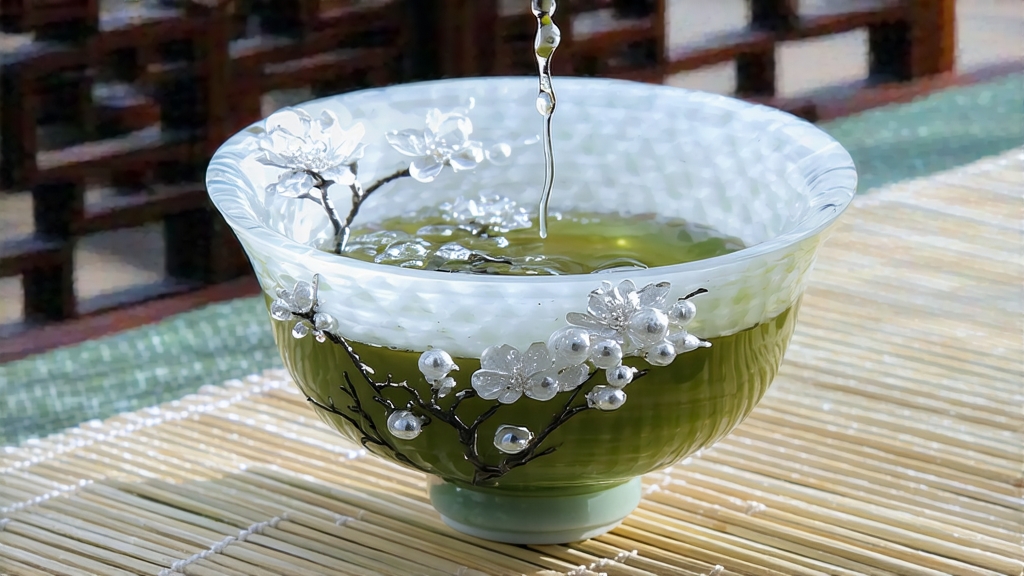
Silver Needle, known in Chinese as Bai Hao Yin Zhen, is the quiet aristocrat of white tea. To the uninitiated it may look like a handful of pale pine needles, yet in the cup it unfurls a fragrance so delicate that poets have likened it to “moonlight drifting across wet marble.” International tea lovers often meet white tea first through bagged blends, but the original loose-leaf Silver Needle remains the benchmark against which all other white teas are measured. This essay invites you to step beyond the teabag and into the misty hills of northern Fujian, where dew, timing and the grower’s intuition decide whether a bud will become a legend.
Historical whispers
White tea’s documented history begins in the Song dynasty (960-1279), when the imperial court demanded “tribute cakes” pressed from downy buds. These cakes were so precious that servants transported them in silk-lined boxes cooled by mountain spring water. By the late Ming (17th century) the fashion shifted to loose-leaf, and Silver Needle emerged as a separate grade. Early European travellers who reached Fuzhou port in 1850 noted “a tea as pale as champagne, tasting of honeyed hay,” almost certainly Silver Needle. Because it was lightly packed and easily spoiled, only small quantities reached London or Amsterdam, securing its mystique and price.
Terroir and micro-seasons
Authentic Silver Needle comes from two counties in Fujian: Fuding and Zhenghe. Within Fuding, the Taimu mountain range catches maritime clouds drifting inland from the East China Sea; the resulting humidity keeps tea bushes succulent, while cool nights slow growth and concentrate amino acids. Zhenghe sits slightly higher and inland, giving marginally cooler days and a stonier soil that yields buds with quieter fragrance but deeper sweetness. Purists can taste the difference: Fuding needles carry a lilac lift, Zhenghe a mellow pear note. Both areas rely on the Da Bai (Big White) cultivar, whose fat spring buds can reach 3 cm and are cloaked in a visible down that reflects light like frost.
Plucking etiquette
The harvest window opens around 15 March and closes before Qingming festival (early April). Only the unopened bud—no leaf, no stem—is picked. Experienced pluckers use thumbnail, not finger pad, to avoid bruising. A full kilogram of finished Silver Needle requires roughly 30 000 buds, all picked before noon when moisture is still high; this prevents premature oxidation during the long wither. Because the work is so labour-intensive, many gardens invite neighbouring villages to join the harvest, turning tea rows into social theatres where songs travel faster than WeChat messages.
Crafting without fire
White tea is defined less by what is done than by what is left undone. Once baskets arrive at the factory, buds are spread on bamboo trays 2 cm thick and placed in a sun-room with 65 % relative humidity and 26 °C. For the next 36–48 hours they lose about 70 % moisture, entering a liminal state that tea scientists call “non-enzymatic browning.” No pan-firing, no rolling, no shaking—only stillness and airflow. Masters gauge readiness by touch: a bud should feel “paper-dry outside, silk-moist inside.” Final drying uses gentle 40 °C ovens for twenty minutes, just enough to lock the moisture at 5 %. The entire process respects the bud’s down, which acts as a natural antioxidant blanket and preserves the silvery appearance that gives the tea its name.
Ageing potential
Unlike green tea, Silver Needle improves with careful ageing. In 2008 the Chinese ministry of commerce approved white tea as a “category suitable for long-term storage,” provided it is kept below 35 °C and 50 % humidity. Over years the chlorophyll breaks down, caffeine complexes with polyphenols, and the cup darkens to antique gold. A 2012 Fuding cake we tasted recently offered notes of dried mango, white pepper and a cooling camphor finish—aromas impossible in a young needle. Collectors store cakes in clay jars wrapped with rice paper, opening them only on mid-autumn nights when moonlight is believed to “awaken” the leaves.
Grades and market names
Walk through any Chinese e-commerce site and you will see “King Silver Needle,” “Supreme Jade Needle,” “Old Tree Snow Needle.” Most are marketing